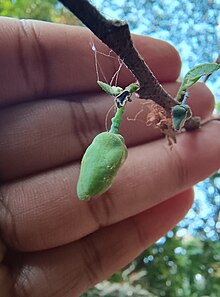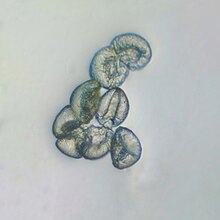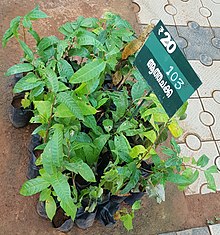| Annona reticulata | |
|---|---|

| |
| Custard apple | |
| Conservation status | |
 Least Concern (IUCN 3.1) | |
| Scientific classification | |
| Kingdom: | Plantae |
| Clade: | Tracheophytes |
| Clade: | Angiosperms |
| Clade: | Magnoliids |
| Order: | Magnoliales |
| Family: | Annonaceae |
| Genus: | Annona |
| Species: | A. reticulata |
| Binomial name | |
| Annona reticulata L. | |

| |
| Native range of A. reticulata | |
| Synonyms | |
|
Annona lutescens Saff. | |
| Nutritional value per 100 g (3.5 oz) | |||||||||||||||||||||||||||||||||||||||||
|---|---|---|---|---|---|---|---|---|---|---|---|---|---|---|---|---|---|---|---|---|---|---|---|---|---|---|---|---|---|---|---|---|---|---|---|---|---|---|---|---|---|
| Energy | 423 kJ (101 kcal) | ||||||||||||||||||||||||||||||||||||||||
| Carbohydrates | 25.2 g | ||||||||||||||||||||||||||||||||||||||||
| Dietary fiber | 2.4 g | ||||||||||||||||||||||||||||||||||||||||
| Fat | 0.6 g | ||||||||||||||||||||||||||||||||||||||||
| Protein | 1.7 g | ||||||||||||||||||||||||||||||||||||||||
| |||||||||||||||||||||||||||||||||||||||||
| Other constituents | Quantity | ||||||||||||||||||||||||||||||||||||||||
| Water | 71.5 g | ||||||||||||||||||||||||||||||||||||||||
Link to USDA Database entry | |||||||||||||||||||||||||||||||||||||||||
| Percentages estimated using US recommendations for adults, except for potassium, which is estimated based on expert recommendation from the National Academies. | |||||||||||||||||||||||||||||||||||||||||
Annona reticulata is a small deciduous or semi-evergreen tree in the plant family Annonaceae. It is best known for its fruit, called custard apple, a common name shared with fruits of several other species in the same genus: A. cherimola and A. squamosa. Other English common names include ox heart and bullock's heart. The fruit is sweet and useful in preparation of desserts, but is generally less popular for eating than that of A. cherimola.
Description



It is a small deciduous or semi-evergreen tree reaching 8–10 metres (26–33 ft) tall with an open, irregular crown.
The slender leaves are hairless, straight and pointed at the apex (in some varieties wrinkled), 10–20 cm (4–8 in) long and 2–7 cm (1–3 in) wide. The yellow-green flowers are generally in clusters of three or four 2–3 cm (3⁄4–1+1⁄4 in) diameter, with three long outer petals and three very small inner ones. Its pollen is shed as permanent tetrads.
The fruits vary in shape, heart-shaped, spherical, oblong or irregular. The size ranges from 7–12 cm (3–4+1⁄2 in), depending on the cultivar. When ripe, the fruit is brown or yellowish, with red highlights and a varying degree of reticulation, depending again on the variety. The flesh varies from juicy and very aromatic to hard with a repulsive taste. The flavor is sweet and pleasant, akin to the taste of 'traditional' custard.
Distribution and habitat

Possibly a native of the Caribbean and Central America, Annona reticulata is now pantropical. It grows from sea level to elevations of 1,500 metres (5,000 ft) in areas of Central America that have alternating wet and dry seasons. It is cultivated and naturalized in many tropical places including Southeast Asia, Taiwan, India, Pakistan, Australia, and Africa. In India, the species has migrated from initial cultivation into the wild.
Climate
Although the tree grows optimally in tropic conditions, it is also found in subtropical regions. It requires humid conditions (medium to high rainfall). Compared to the other Annona, it is less drought tolerant. The annual temperature necessary ranges from 17 to 27 °C (63 to 81 °F). It tolerates light night frosts to −2 °C (28 °F). A. reticulata grows on many soil types with pH ranging from 5 to 8. It does not tolerate waterlogging or when the water table is too high.
Cultivation
Seeds can be propagated. Other techniques for cultivation are grafting and budding. The tree produces 45 kg of fruits per year. In Asia, the season lasts from July to September, and in the Caribbean, it runs from February to April.
Uses
Food
Custard apple can be eaten raw, out of hand as a fresh fruit. It is not as popular as the sugar apple or the cherimoya. It can also be prepared as juices, ice-cream or puddings. In India, it is cooked into a sauce.
Propagation
A. reticulata may be grown in home gardens, even though it may not be as popular as the sugar apple (A. squamosa). It has value as rootstock for superior Annona species, such as the sugar apple, especially under humid conditions. It is also a genetic resource for hybridization.
Other
The leaves and the branches can be used for tanning as they contain blue pigments. Wrappers, ornaments and hats can be made from the inner bark. The wood is soft and can be used to make utensils, even though, it is weak and of bad quality.
Nutrition
In a 100-gram reference amount, custard apple supplies 423 kilojoules (101 kilocalories) of food energy, 23% of the Daily Value (DV) of vitamin C and 17% DV of vitamin B6, with no other micronutrients in significant amounts (table). Raw custard apple is 72% water, 25% carbohydrates, 2% protein, and 1% fat (table).
Risk and impact
Annona reticulata is known to be an invasive plant. A PIER risk assessment gave a score of 11 for the Annona reticulata. It negatively impacts the population cultivating the crop as all parts of the tree (except the fruit) are toxic, possibly causing problems for human health.
Diseases and pests
The diseases that can spread to Annona reticulata include the Anthracnose, the leaf spot, the diplodia rot and the black canker. The spiral nematode, the stunt nematode and the mealybug can also infect the plant
Aroma and phytochemicals
The fragrant aroma of A. reticulata results from some 180 compounds, including the volatile compounds, alpha-pinene, myrcene, and limonene, among others. The plant is rich in tannins.
Traditional medicine
Various traditional medicine uses have been reported over centuries for its dried fruits, bark, or leaves.
References
- Verspagen, N. & Erkens, R.H.J. (2020). "Annona reticulata". IUCN Red List of Threatened Species. 2020: e.T136996530A142422959. doi:10.2305/IUCN.UK.2020-2.RLTS.T136996530A142422959.en. Retrieved 10 December 2022.
- ^ "Annona reticulata". Germplasm Resources Information Network. Agricultural Research Service, United States Department of Agriculture. Retrieved 16 April 2008.
- United States Food and Drug Administration (2024). "Daily Value on the Nutrition and Supplement Facts Labels". FDA. Archived from the original on 27 March 2024. Retrieved 28 March 2024.
- National Academies of Sciences, Engineering, and Medicine; Health and Medicine Division; Food and Nutrition Board; Committee to Review the Dietary Reference Intakes for Sodium and Potassium (2019). "Chapter 4: Potassium: Dietary Reference Intakes for Adequacy". In Oria, Maria; Harrison, Meghan; Stallings, Virginia A. (eds.). Dietary Reference Intakes for Sodium and Potassium. The National Academies Collection: Reports funded by National Institutes of Health. Washington, DC: National Academies Press (US). pp. 120–121. doi:10.17226/25353. ISBN 978-0-309-48834-1. PMID 30844154. Retrieved 5 December 2024.
- Natural Resources Conservation Service. "Plants Profile, Annona reticulata L." The Plants Database. United States Department of Agriculture. Retrieved 16 April 2008.
- "Annona cherimola". Germplasm Resources Information Network. Agricultural Research Service, United States Department of Agriculture. Retrieved 17 April 2008.
- "Annona squamosa". Germplasm Resources Information Network. Agricultural Research Service, United States Department of Agriculture. Retrieved 17 April 2008.
- ^ "Annona reticulata (bullock's heart)". CABI. 31 October 2019. Retrieved 13 November 2019.
- ^ Julia F. Morton (1987). "Custard apple, Annona reticulata". From Fruits of Warm Climates, 1987; republished by NewCROP, the New Crop Resource Online Program, Center for New Crops & Plant Products, Purdue University. Retrieved 13 November 2019.
- Walker JW (1971) Pollen Morphology, Phytogeography, and Phylogeny of the Annonaceae. Contributions from the Gray Herbarium of Harvard University, 202: 1–130.
- ^ "Annona reticulata Linn. [family Annonaceae]". Global Plants. JSTOR. Retrieved 5 September 2019.
- Bioversity International. "Result set for: Annonaceae Annona reticulata". New World Fruits Database. Retrieved 16 April 2008.
- ^ Subhadra Bandhu, S. (2001). Underutilized tropical fruits of Thailand.
- ^ National Research Council (1989). "Lost crops of the Incas: little-known plants of the Andes with promise for worldwide cultivation". National Academies Press.
- "Plantes botaniques". 19 January 2020.
- "USDA. US Department of Agriculture".
- "Custard Apple Diseases". Vikaspedia. Retrieved 1 December 2019.
- Pino, JA; Marbot, R; Fuentes, V (18 June 2003). "Characterization of volatiles in bullock's heart (Annona reticulata L.) fruit cultivars from Cuba". Journal of Agricultural and Food Chemistry. 51 (13): 3836–9. Bibcode:2003JAFC...51.3836P. doi:10.1021/jf020733y. ISSN 0021-8561. PMID 12797752.
External links
- Custard apples (Annona spp.) by H. Mahdeem, 5 July 1998.
| Taxon identifiers | |
|---|---|
| Annona reticulata |
|